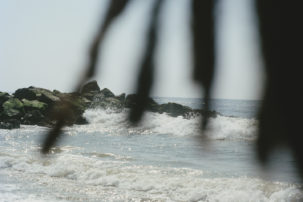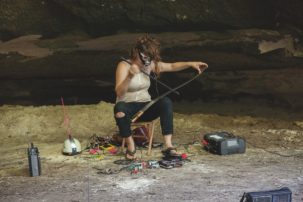It’s mid-May, two months into the pandemic, and cheers for frontline workers still sound out each evening across my West End Vancouver neighbourhood. Thank-you signs and banners, amateur trumpet refrains and jubilant car-honking are now understood as tributes to medical, transit and other city workers, but also to the much less visible maintenance, delivery and service workers who continue to carry out their tasks inside long-term care homes, hospitals, warehouses and shipping depots.
The image of the working body has long been instrumentalized as an economy-driver, a nation-builder, the symbol of a collective ethos. But these images are always selective, highlighting certain labouring bodies while rendering others invisible. When I was asked this spring to write about Vancouver artist Stan Douglas’s work, the ubiquity of the emerging dichotomies of the COVID-19-era worker—essential/home office, seen/unseen—brought my attention to an image I encountered as a curatorial and collections assistant at the Art Museum at the University of Toronto. The work was titled Maritime Worker’s Hall, Vancouver (2006), part of the Hart House Collection. What stood out in my memory was Douglas’s transformation of an ordinary, empty meeting hall, complete with tidy rows of chairs, into the dramatic frame for a large painted mural. This work was part of Douglas’s 2006 Western series, which features building interiors and rural landscapes as devoid of, but indexes for, human presence.
Revisiting this series now to consider work without workers’ bodies, I wonder: How can we read Douglas’s images for what they reveal about the body of the worker, who, when unseen, can be misgendered, deracialized and mythologized? What implications of the where and the who of the working body are overwritten when workers are unseen or anonymized?
How can we read Douglas’s images for what they reveal about the body of the worker, who, when unseen, can be misgendered, deracialized and mythologized?
One of Douglas’s earlier works, Onomatopoeia (1985–86), introduces his interest in staging the anonymous worker in a modernity identified with technology and reproduction. This installation, first shown at the Western Front, features a player piano, an instrument associated with the ragtime era of the late 19th and early 20th centuries. While the piano plays an excerpt of Beethoven’s Piano Sonata No. 32, Opus 111, images of automated looms in an industrialized textile mill are projected on a wall above. The sonata is arranged in a proto-jazz rendition that recalls African American composers and musicians such as Jelly Roll Morton and Scott Joplin, but neither a musician nor a factory worker is seen. Onomatopoeia is often discussed for its juxtaposition of automated industry and American popular culture as a critique of Frankfurt School philosopher Theodor Adorno’s dismissal of jazz as an authorless, assembly-line commodity rather than culture. Ragtime and the American textile industry are synonymous with the emergence of American industrial and cultural dominance. They are also tightly bonded to Black enslavement, migratory labour and socioeconomic marginalization, enough to racialize the space of Onomatopoeia’s absent performers and labourers, if not their identities.
Space as an index of a non-essentialized identity and body is partly influenced by Douglas’s deep appreciation for the work of Samuel Beckett. According to scholar Mona Hashish, Beckett’s protagonists are often voices that “lack both physical and social locations” such as age, gender, race or class. Douglas himself curated the exhibition “Samuel Beckett: Teleplays” in 1988, for which his catalogue essay described the Irish playwright’s “persistent distrust of discrete self-identity, and the potentially authoritarian subject that lies behind any such identification.”
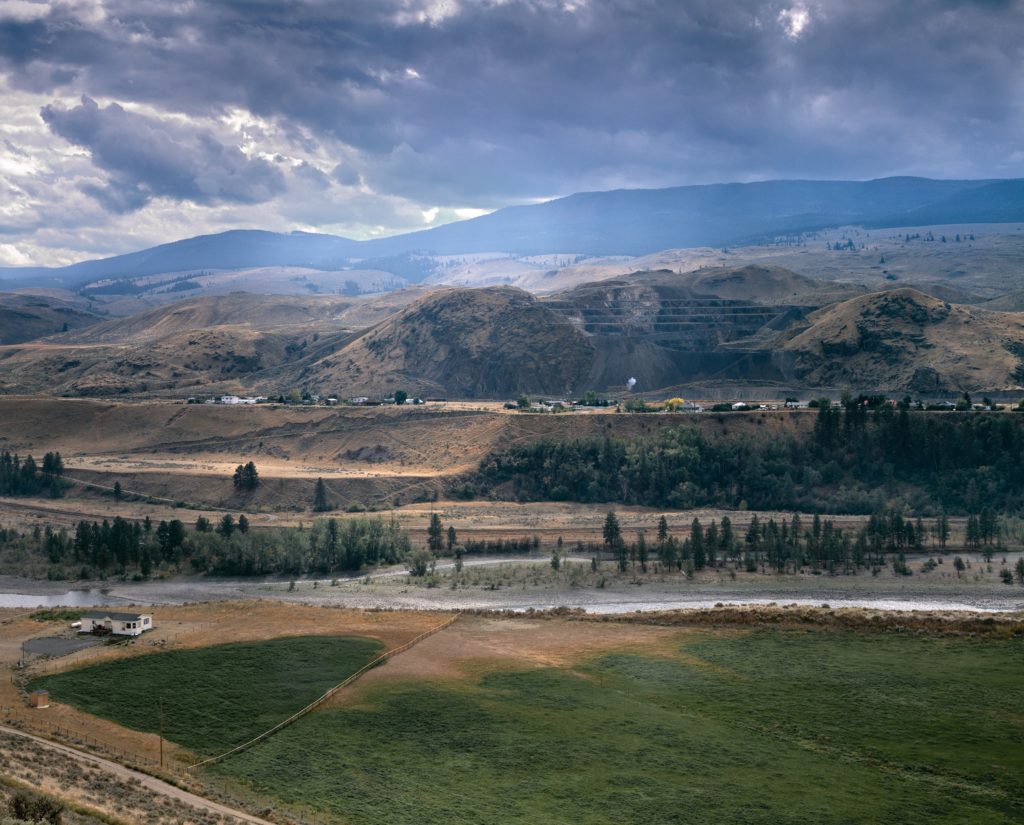 Stan Douglas, Walhachin, 2006. Chromogenic print, 1.37 x 1.7 m. Courtesy Vancouver Art Gallery.
Stan Douglas, Walhachin, 2006. Chromogenic print, 1.37 x 1.7 m. Courtesy Vancouver Art Gallery.
Douglas’s conceptual rigour was widely lauded by the time he produced the Western series. Its landscapes, building interiors and ruins along the Gold Rush Trail are sites associated with the 19th-century westward expansion of settlers and miners. The picture-in-picture image of Maritime Worker’s Hall juxtaposes a romanticized mural with the tranquil, eponymous hall. But the only workers visible are those pictured in the expansive mural that dominates the hall, dwarfing the entryway and empty chairs beneath it. The dramatic contrast between darkened auditorium and illuminated mural evokes a sense of theatricality common in Douglas’s work. Douglas positions the viewer parallel to the mural to allow for contemplation of its painted landscapes of far-reaching sea and sky—which is not the point of view of the hall’s workers, who would sit below.
Douglas donated Maritime Worker’s Hall to the Hart House Collection at the start of an era when curator Barbara Fischer began acquiring works like Douglas’s to both redress and engage the collection’s early domination by the landscape painting of British and white, and mostly male, Canadian artists, particularly members of the Group of Seven and their peers. Douglas countered the Canadian “empty landscape” genre’s amnesic representation of a wilderness free of the large-scale exploitation of natural resources, and its erasure of traces of Indigenous labour and custodianship on the land. Speaking in 2007 to writer Robert Enright for Frieze about the series Nootka Sound (1996)—which Douglas describes as an “anti-Group of Seven piece”—the artist explained:
The ‘Nootka Sound’ pictures cover an area which to the untrained eye seems like a natural situation. But if you look at it carefully, you realize it’s been logged at least twice. Plus I was looking at different traces of human presence there: either swamps created by the run-off from logging, a fish trap that is 3,000 years old and still in use, a well that was built by the Spanish when they were there in the 18th century or the replica of a longhouse inside a Catholic church that was a gift from the Spanish state, perversely commemorating their conquest of the area.
The landscape mural in Maritime Worker’s Hall was painted by artist Fraser Wilson in 1947 and later cut from its original site, in the Marine Workers and Boilermakers Industrial Union hall, to be installed in Vancouver’s Maritime Labour Centre in the late 1980s. Its social-realist style figures the workers’ role in the harvesting of natural resources and neocolonial nation-building, but their diminutive scale is less heroic than those of similarly styled worker murals. We see timber being guided along waterways, commercial fishing boats manoeuvring between massive steamships and shipyards, a miner emerging from the mountainside with more coal to sustain the smokestacked factories, and a growing city outlined in the distance. A worker in the foreground, framed by a ship aptly called the Canadian Constructor, wears a welder’s mask that obscures his face, making him the “everyman” of settlers. The few other workers pictured are barely discernible from their machinery and harvested wood. Not seen are Indigenous and racialized workers. Here, the only visible workers, the white workers, are fixed in place; they are part of the landscape.
The few other workers pictured [in Wilson’s mural] are barely discernible from their machinery and harvested wood. Not seen are Indigenous and racialized workers. Here, the only visible workers, the white workers, are fixed in place; they are part of the landscape.
In a hall for unions, whose precise function is to counter the invisibility of labour, Douglas’s photographic reframing invisibilizes workers to critique the idealized Canadian worker in Wilson’s mural. The visibility and invisibility of workers is rarely incidental to a worker’s race, class and gender, as scholar Françoise Vergès illustrates in her 2019 essay “Capitalocene, Waste, Race, and Gender.” Referring to Black cleaners in France, she describes how gendered and racialized divisions of labour are echoed in divisions of space to affirm indispensable, undervalued and invisibilized working bodies:
The working body that is made visible is the concern of an ever growing industry dedicated to the cleanliness and healthiness of body and mind, the better to serve racial capitalism. The other working body is made invisible even though it performs a necessary function for the first: to clean spaces in which the “clean” ones circulate, work, eat, sleep, have sex, and perform parenting. But the cleaners’ invisibility is required and naturalized.
By absenting the hall’s workers, Douglas makes invisible the connection between specific types of bodies and the conditions of labour. The erasure and diminution of the racialized and gendered workers also erases their integral role in functioning societies, as well as in capital and wealth.
The invisibility exacerbated by the lockdowns, combined with an assumed uniformity of the experiences and conditions of essential workers, has resulted in worker deaths in cities with high infection rates, such as Montreal, where it was reported that many essential services were performed throughout the pandemic by racialized workers residing in the city’s low-income neighbourhoods. The availability of underpaid and unsafe jobs to immigrant communities, who are already limited to affordable but substandard housing, have made those marked by racialization especially vulnerable to infection and death due to COVID-19. Following calls in the United States to release race-based data on pandemic deaths, similar refrains in Canada have argued for the collection of such data, assuming that the statistical visibility of gendered and racialized bodies deemed essential workers will encourage labour protections for those from whom society extracts sacrifice, convenience and care.
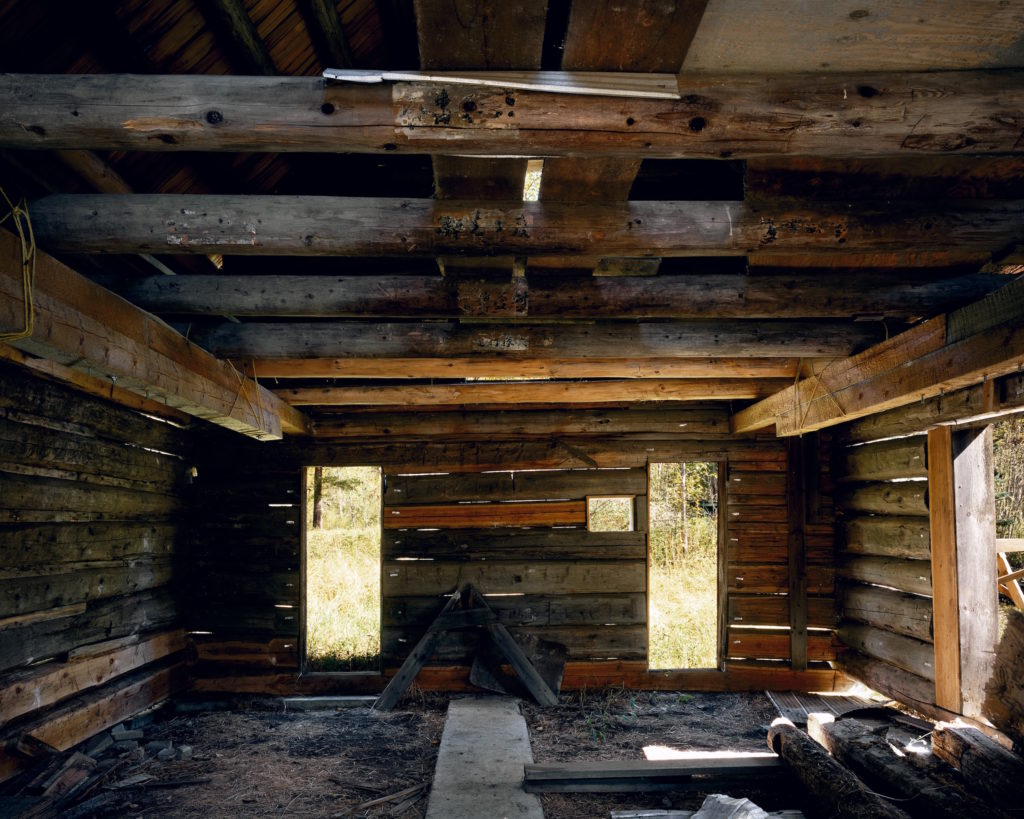 Stan Douglas, Tong Building, Quesnel Forks, 2006. Chromogenic print, 47.7 x 60 cm. Courtesy Vancouver Art Gallery.
Stan Douglas, Tong Building, Quesnel Forks, 2006. Chromogenic print, 47.7 x 60 cm. Courtesy Vancouver Art Gallery.
The landscapes and building interiors in Douglas’s Western series frame the traces of past and contemporary communities of workers. Despite this invisibility, the mundane and marginal settings of his cinematic panoramas and atmospheric interiors draw attention to minor narratives of place and labour. But if the intended viewers of these photographs aren’t the workers themselves, whose imaginary is permitted to describe those narratives? The absence of what visual culture and contemporary art theorist Tina Campt terms the “confrontational practice of visibility” allows for the erasure of any individualized presence, including those racialized and classed, that challenges dominant and exclusionary narratives of labour in BC and elsewhere.
But if the intended viewers of these photographs aren’t the workers themselves, whose imaginary is permitted to describe those narratives?
Douglas’s Tong Building, Quesnel Forks (2006) is photographed from the interior of a decrepit wooden structure. Daylight pours in from the entryways and gaps in the wooden beams. Outside, there is visible overgrowth and a few small trees. This building hosted labourers on the Gold Rush Trail. The work’s title identifies the region and the building as part of an early outpost of Chinese Canadian business and trade with miners. The Chee Kung Tong, known also as Chinese Freemasons, constructed such buildings to support Chinese workers, including miners, as well as immigrants, and develop a sense of community. Tong Building and other photographs from the series—Stanley Cemetery, Spences Bridge and Masonic Lodge, Barkerville—are inscribed by migration and labour. Douglas described the sites in his images as “less about absence than the stage of an action.” Photographed nearly a century after settlements like Barkerville ceased to be active worksites, Douglas’s images engage a Beckettian decentring of the human subject, substituting space for a universalized and mythologized body of the long-departed miner.
In his 1983 essay “Photography Between Labour and Capital,” writer and artist Allan Sekula compares commercial and everyday photographs of another Canadian mining town to reveal underlying local economies. He notes that despite two sets of photographs having been produced in the same studio (Leslie Shedden’s) in 1950s Glace Bay, Nova Scotia—those commissioned by miners and those commissioned by the local mining company—each fulfills an agenda around visibility and invisibility. For Sekula, viewing these photographs as parts of a single archive reaffirms asymmetries of power, distance and the control of (in)visibility:
[S]ome of the photographs in this book were originally reproduced in the annual reports of the Dominion Steel and Coal Company, others were carried in miners’ wallets or framed on the mantelpieces of working-class homes…. Imagine the gaze of a stockholder… thumbing his way to the table of earnings and lingering for a moment on the picture of a mining machine, presumably the concrete source of the abstract wealth being accounted for in those pages. Imagine the gaze of a miner, or of a miner’s spouse, child, parent, sibling, lover, or friend drifting to a portrait during breaks or odd moments during the working day.
The miners and their families sought visual documentation of themselves both as workers and as more than workers. The images commissioned by the mining corporation featured the machine technology of the mining installations and enabled the intended viewers, their shareholders, to distance their own benefit from the value produced in the mines through the body of the worker. Sekula perceives the visibility of the worker, reaffirmed through viewership of their portrait, as “radical antagonism” to the bodiless labour and wealth-generation desired by the mining company’s shareholders.
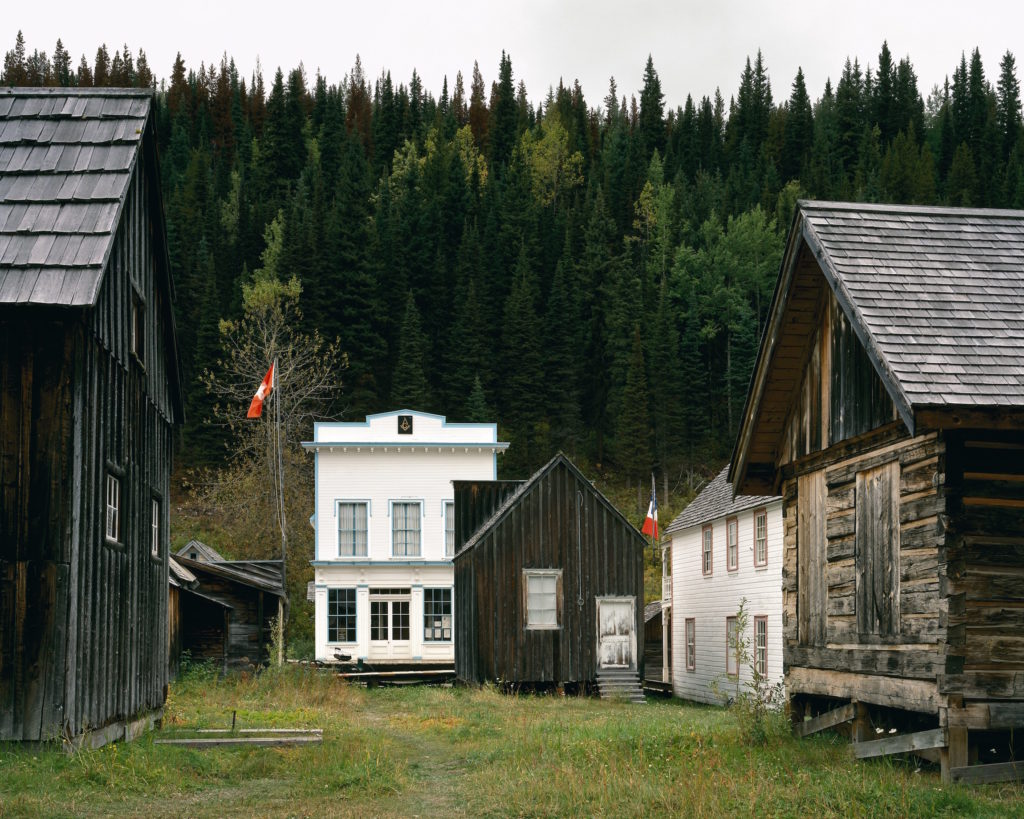 Stan Douglas, Masonic Lodge, Barkerville, 2006. Chromogenic print, 84 x 83.49 cm. Courtesy Vancouver Art Gallery.
Stan Douglas, Masonic Lodge, Barkerville, 2006. Chromogenic print, 84 x 83.49 cm. Courtesy Vancouver Art Gallery.
Taking into account how invisibilized bodies engender social erasure, writer and scholar Gabrielle Moser examines Douglas’s earlier image of a depopulated Vancouver street in her 2011 essay “Phantasmagoric Places: Local and Global Tensions in the Circulation of Stan Douglas’s Every Building on 100 West Hastings.” Here, Moser notes that what’s made invisible is not just a vulnerable community, but the local effects of deteriorated manufacturing industries on contemporary Vancouver. Industrial production toward the city’s eastern limits gave way to a service-based economy that increasingly gentrified the city and marginalized its blue-collar workers. The urban centre depicted in this photograph, the Downtown Eastside, is widely known for the visibility of many impoverished and distressed residents. With this in mind, Moser examined the implications of Douglas’s decision to excise any visible residents of the area, leaving only the buildings and street architecture:
On the one hand, we can read the dematerialization of human subjects in the streetscape as a critical mirroring of the active dematerialization of people in the Downtown Eastside; on the other, this depopulation of the landscape is essential to the aestheticization of the streetscape and its appropriation as a high art image. By presenting an empty landscape, Douglas’s image invites viewers to project their own desires onto the photograph.
Moser also points out that Every Building on 100 West Hastings was on display in the reception area of a Toronto corporate law office, where the viewer, similar to Sekula’s shareholder, is separated from Douglas’s Hastings Street community through distance, wealth and privilege, and disentangled from their own accountability to the precarious conditions of its unseen residents.
Images like Maritime Worker’s Hall are reminders of the disingenuousness of our current cultural assessment of unseen workers—how work without bodies is idealized and how capital interests erase conditions of that work. This absenting of bodies, especially racialized bodies, from visual representations is not a de facto gesture of inclusivity over identity. Rather, such invisibility risks foreclosing the possibilities for collective empathy and the disruptive potential of images to challenge erasures in histories of art and labour alike.

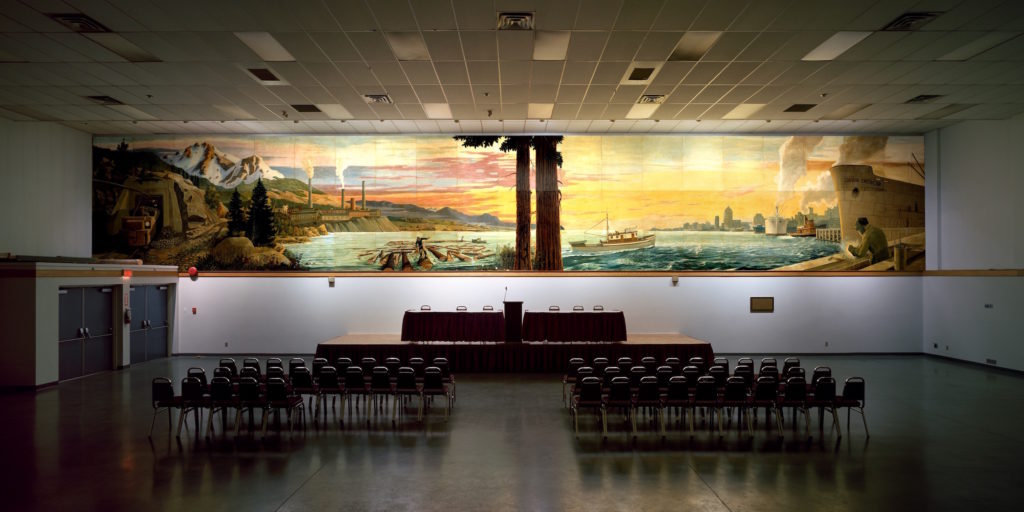 Stan Douglas, Maritime Worker's Hall, Vancouver, 2006. Chromogenic print, 1.3 x 2.6 m. Courtesy Vancouver Art Gallery.
Stan Douglas, Maritime Worker's Hall, Vancouver, 2006. Chromogenic print, 1.3 x 2.6 m. Courtesy Vancouver Art Gallery.

